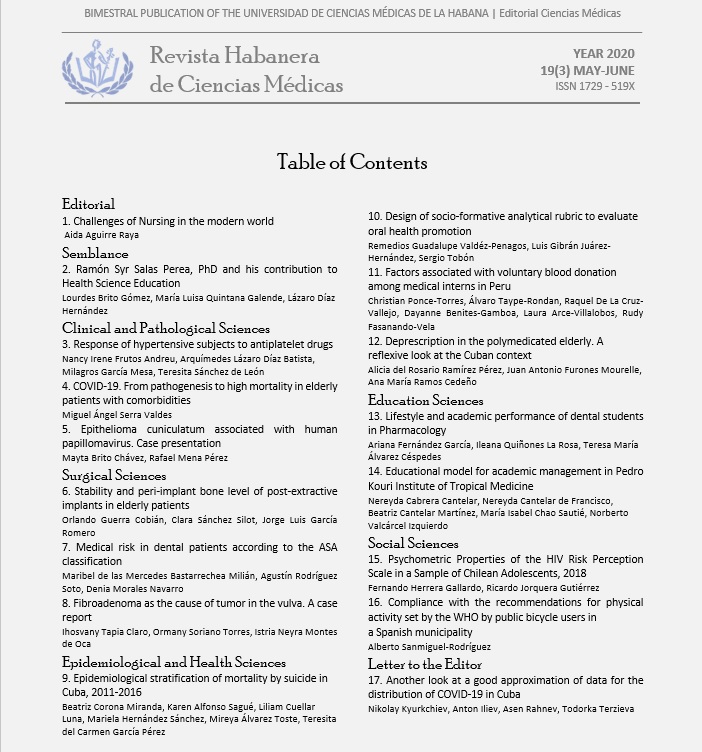Stability and peri-implant bone level of post-extractive implants in elderly patients
Keywords:
Post-extractive implants, stability, peri-implant bone loss, elderly patientsAbstract
Introduction: Post-extractive implants shorten the time in achieving the rehabilitation of the patient, being this condition an essential factor to restore the quality of life to elderly patients at short term.
Objective: To determine the stability values and peri-implant bone loss in post-extractive implants in elderly patients.
Material and Method: A cohort study was carried out in 99 elderly patients at Raúl González Sánchez Dental School of Havana from 2017 to 2019. Under the consent of the patients, 173 post-extractive implants were placed. Bone support type, and primary and secondary stability were determined on the basis of a resonance frequency analysis with Ostell Mentor®. The peri-implant bone level and peri-implant bone loss were measured until 12 months after rehabilitation.
Results: Implants were mainly positioned in the maxillary incisive site in 43,3 % of the cases. The average values of primary and secondary stability were 48 ISQ and 68 ISQ, respectively. The average bone loss after 12 months of rehabilitation was 1,04 ± 0,22 mm.
Conclusions: Post-extractive dental implants were inserted preferably in the maxillary incisive site and in D2 bone type, registering moderated average values of primary stability and substantial average values of secondary stability. The peri-implant vertical bone loss exhibited implants with similar values than those in the healed areas and within the standardized value for peri-implant bone loss within the first year after implant placement.Downloads
References
1. Mazzocco F, Jiménez D, Barallat L. Bone volume changes after immediate implant placement with or without flap elevation. Clin Oral Impl Res [Internet]. 2017 Apr [Citado 24/06/2017];28(4):495-501. Disponible en: http://dx.doi.org/ 10.1111/clr.12826
2. Schulte W, Kleineikenscheidt H, Lindner K, Schareyka R. The Tubingen immediate implant in clinical studies. DtschZahnarztl Z. 1978; 33:348-59.
3. Ramos A. Taller 1 - Momento idóneo para la inserción del implante, inmediato, temprano o diferido. Odontoestomatología. [Internet]. 2017 Sept [Citado 26/11/ 2018] ;19(5):[aprox. 2 p.]. Disponible en: http://dx.doi.org/10.22592/ode2017n.esp.p5
4. Guerra Cobián O. Evaluación de la estabilidad de implantes dentales mediante análisis de frecuencia de resonancia. Revhabanciencméd. [Internet]. 2015 Ago. [Citado 14/11/2018];14(4):460-9. Disponible en: http://scielo.sld.cu/scielo.php?script=sci_arttext&pid=S1729-519X2015000400009&lng=es
5. Pereira ON. Evaluación de la estabilidad primaria como el factor clave en la rehabilitación oral con implantes inmediatos postextracción. [Tesis Maestría]. Sevilla: Universidad de Sevilla; 2017. [Citado 28/11/2018]. Disponible en: https://idus.us.es/xmlui/bitstream/handle/
6. Novellino M. Resonance frequency analysis of dental implants placed at the posterior maxilla varying the surface treatment only: A randomized clinical trial. Clin Implant Dent Relat Res. [Internet]. 2017 Feb [Citado 16/11/2018]; 19:770-75. Disponible en: http://dx.doi.org/10.1111/cid.12510
7. Guerra Cobián O. Consideraciones clínicas y éticas en la implementación de rehabilitaciones implantoprotésicas en el adulto mayor. RevHumMed. [Internet].2018 Ago [Citado 30/11/2018];18(2):311-25. Disponible en: http://scielo.sld.cu/scielo.php?script=sci_artext&pid=S172781202018000200311&lng=es.
8. Simonpieri A, Gasparro R. Four-year post-loading results of full-arch rehabilitation with immediate placement and immediate loading implants: A retrospective controlled study. QuintessenceInt. [Internet]. 2017 Abril [Citado 25/11/2018];48(4):315-24. Disponible en: http://dx.doi.org/10.3290/j.qi.a37894
9. Garlini G, Chierichetti V. Single Post-Extractive Implants with Immediate Loading: Soft Tissue Response After 10 Years. Oral Health and Dentistry. [Internet]. 2017 Marzo [Citado 26/11/2018];1(1):72-82. Disponible en: https://www.scientiacerca.c/srohde/pdf/SROHDE-01-000012.pdf
10. Romanos G, Delgado Ruiz R. Influence of the implant diameter and bone quality on the primary stability of porous tantalum trabecular metal dental implants: an in vitro biomechanical study. Clin Oral Impl Res [Internet]. 2018 Jun [Citado 30/11/2018];29(6):649-55. Disponible en: https://onlinelibrary.wiley.con/doi/abs/10.1111/clr.12792
11. Cucchi A, Vignudelli E, Franco S, Levrini L, Castellani D, Pagliani L, et al. Tapered, double-lead threads single implants placed in fresh extraction sockets and healed sites of the posterior jaws: A multicenter randomized controlled trial with 1 to 3 years of follow-Up. Bio Med Res Int [Internet]. 2017 Sept. Aprox.16 p. [Citado 25/11/2018]; 2017:8017175. Disponible en: https://doi.org/10.1155/2017/8017175
12. Kim JK. Clinical and radiographic outcomes of immediate and delayed placement of dental implants in molar and premolar regions. Clin Imp Dent Rel Res [Internet]. 2017 May [Citado 25/11/2018]; 19(4):703-9. Disponible en: https://doi.org/10.1111/cid.12496
13.Gerhke SA, Tavares da Silva U. Stability of implants placed in fresh sockets versus healed alveolar sites: Early findings. Clin Oral Impl Res [Internet]. 2016 Sept [Citado 25/11/2018];27(5):577-82. Disponible en: https://doi.org/10.1111/clr.12624
14. Milillo L, Fiandaca C. Immediate vs Non immediate loading post extractive implants: a comparative study of implant stability quotient(ISQ). Oral Implantol [Internet]. 2016 Sept [Citado 30/11/2018];9(3):123-31. Disponible en: https://doi.org/10.11138/orl/2016.9.3.123
15. Wojtovicz E, Jiménez Guerra A. Seguimiento clínico de cuatro años de implantes unitarios anteriores insertados en alveolos postextracción. Av Odontoestomatol [Internet]. 2017 jun [Citado 28/11/2018];33(5):239-46. Disponible en: http://scielo.isciii.es/pdf/odo/v33n5/0213-1285-odonto-33-5-239.pdf
16. Rodrigo D, Martín C. Biological complications and periimplant clinical and radiographic changes at immediately placed dental implants. A prospective 5-year cohort study. Clin Oral Impl Res [Internet]. 2012 Jun [Citado 10/11/2018]; 2012(23):1224-31. Disponible en: https://doi.org/10.1111/j.1600-0501.2011.02294.x



